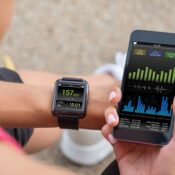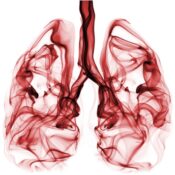In the final part of our series on the difference between heart attacks and sudden cardiac arrest (SCA), heart rhythm specialist Dr. Richard Page discusses what to do if you witness an SCA—a malfunction in the heart’s electrical system that claims the lives of more than 250,000 Americans each year—and why portable defibrillators called Automated External Defibrillators (AEDs) should be as commonplace as fire extinguishers.
AEDs are computerized devices that check a person’s heart rhythm and deliver a shock to restore a heartbeat, if needed. Odds of surviving SCA drop about 10 percent every minute that a shock is not received.
“I like the analogy of AEDs and fire extinguishers,” says Dr. Page. “It’s unthinkable to not have fire extinguishers or smoke detectors in public places. When I give lectures about AEDs, I can usually spot a fire extinguisher nearby. But in many cases, I have not seen an AED on my way to the podium.”
Post: When were portable defibrillators first used in the U.S.?
Dr. Page: They were introduced in the 1990s, and American Airlines began putting defibrillators on aircraft in 1997. I was at the University of Texas Southwestern Medical Center in Dallas at the time. We worked with American Airlines and I reported the experience in the New England Journal of Medicine. A study of AEDs in casinos was conducted at the same time and those results appeared back-to-back with the aircraft article. In 2000, the American Heart Association named the AED one of the top 10 cardiac research advances. It’s gratifying that AEDs are being placed in more and more venues. But it’s distressing that they aren’t everywhere yet.
It is important to note that AEDs are automated external defibrillators rather than automatic external defibrillators. People get this wrong all the time. There is a wearable vest defibrillator that automatically gives a shock for SCA. But the AEDs in health clubs, hospitals, police cars, aircraft, and casinos are automated, not automatic. These devices will not deliver a shock until the human operator pushes a flashing red button.
Post: Who can use a portable defibrillator?
Dr. Page: I think anyone can. Some states require authorization to use these devices, and I support the American Heart Association’s efforts to train the public. But the simplicity of these devices was demonstrated by investigators in Seattle, who did a small study with mannequins, 6th graders, and paramedics. They instructed the 6th graders (who had no prior experience with an AED) to figure out the device and save the life of a mannequin. Results published in the journal, Circulation, one of the best heart journals, showed that 6th graders delivered a shock in 92 seconds. Well-trained Seattle paramedics accomplished it in 60 seconds. So it is better to be trained, but almost anyone can figure out how to use an AED.
Training is important, but if I had a cardiac arrest and no one knew how to use an AED, I’d much rather that a bystander try to figure it out than wait 10 minutes for an ambulance to get to me. In the casino experience, a setting in which every arrest was videotaped, three out of four victims survived if they were shocked within three minutes. In contrast, less than one in 20 survives SCA in most cities.
Post: What about “no-hands” CPR?
Dr. Page: I was one of the co-authors that issued the AHA scientific advisory statement in 2008 recommending compression-only CPR for adults who experience sudden cardiac arrest outside of the hospital. The advisory group and the American Heart Association have gotten behind the idea of hands-only CPR.
This makes sense for many reasons. For example, if I have sudden cardiac arrest right now, I have plenty of oxygen in my blood—what I need is circulation. We know from some very important research in animals and in humans that in CPR you need to pump hard, fast, and continuously to maintain blood pressure. After every pause in chest compression, you have to work to build up the blood pressure again. Mouth-to-mouth breathing probably isn’t necessary. Chest compressions actually move some air, too.
Post: Can someone be sued for using an AED if the victim dies or gets brain damage?
Dr. Page: Probably not, because every state has Good Samaritan laws in place. The operator has almost no liability risk, as long as he or she is operating in the best interest of the individual.
Post: You mentioned earlier that these devices are more accessible, but there aren’t enough of them. Why is that?
Dr. Page: One challenge is public awareness, getting the word out. Another is a mistaken concern about liability, as we’ve discussed. And finally, cost is an issue. If AEDs cost the same as fire extinguishers or smoke detectors, we would have more of them out there. I don’t generally support AEDs in homes because the overall likelihood of one being used is so small that our health dollars would probably be better served in other ways.
Post: Even though most sudden cardiac arrests happen at home?
Dr. Page: Yes. The problem is that many of these events occur when the person is asleep or alone, so having an AED would be of no benefit. Although a home AED would not hurt, and some people elect to purchase these, I am primarily interested in campaigns to place AEDs in more public places.
Post: If people are interested in doing something like that, where do they start?
Dr. Page: They can contact the Heart Rhythm Society or the American Heart Association for advice. The Heart Rhythm Society has advocated strongly on behalf of patients at risk for and who have experienced cardiac arrest, and we maintain an active Web site. Area physicians may also be a good resource for grassroots campaigns and local champions.
Post: What do you expect might be the next breakthroughs in preventing SCA and saving lives?
Dr. Page: I envision two avenues. One is better identification of those individuals who are at the highest risk for SCA and would benefit most from an ICD to modify that risk. The second (because we won’t identify everybody at risk) is to increase awareness of SCA, improve accessibility to AEDs, and increase the number of people who are trained in CPR and AED use.
I’ll tell you an interesting story that occurred while Charlie Jones, Heart Rhythm Society Vice President of Marketing, Communications and Membership, and I were visiting a number of media outlets on the east coast. After we landed in D.C. and were driving away from National Airport, Charlie noticed something unusual by the side of the road and said, “I think someone’s down there.”
We stopped, and there was a man in his 50s who had experienced sudden cardiac arrest while jogging along the road. Bystanders were already doing two-person CPR with beautiful respirations, so I didn’t interfere with that other than to take my turn at chest compressions. Occasionally the victim would make a gasping breath and people said, “Oh, he’s breathing, let’s stop.” But I said, “No, no, keep going” because I knew the gasping breath was a brain stem response, not a conscious one. When the ambulance arrived with the AED, a single shock was delivered. One shock, and he had been down probably 15 minutes or more! He awoke and actually gave us a thumbs-up when he got in the ambulance.
Isn’t that amazing? The experience reminded me that CPR, when well performed, pumps blood well to the heart and brain. CPR can keep someone alive until the person gets that lifesaving shock from the AED. Being familiar with CPR and AEDs really does save lives.
Click here for Part 1: Understanding SCA. 5 facts about sudden cardiac arrest and heart attack.
Click here for Part 2: Preventing SCA. Are you at risk?
Become a Saturday Evening Post member and enjoy unlimited access. Subscribe now



